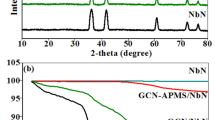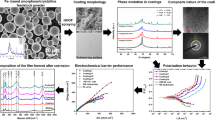Abstract
Nature-inspired hydrophobic coatings have caught great attention due to their repellency to corrosive mediums and less interaction between substrate and chemical species. Aluminum is considered one of the metals having superior properties against corrosion due to passive film formation. It can further be enhanced by the formation of a hierarchical structure through 2nd step anodization. In previous studies, carbon infiltrated in anodized alumina pores through CVD method (chemical vapor deposition) was quite an expensive and complex method. The fabrication of anti-corrosion coating with a simple and cost-effective method will broaden the aluminum alloy applications in the chemical, petrochemical, and aerospace industries, etc. In this research, pyrolytic carbon is infiltrated in porous alumina through pyrolysis at three different temperatures for 30 min under a controlled environment by using flaxseed oil as a source of carbon. The surface morphology along with chemical composition and wetting angle were studied through SEM (Scanning Electron Microscope), EDX (Energy Dispersive X-ray Spectroscopy), and Sessile drop method. It was found that both low surface energy and high roughness participate in increasing the wetting angle. Nanocomposite coating having maximum carbon content has a maximum wetting angle with inorganic liquid. Based on the electrochemical behavior determined by Tafel and EIS (Electrochemical Impedance Spectroscopy) analysis, the hydrophobic coating containing 57.5% carbon content having a contact angle of 95° exhibits maximum corrosion resistance of around 28,000 kohm as compared to anodized aluminum having minimum corrosion resistance of around 4.26 kohm. The results and the cost-effective method could be beneficial in aircraft parts as well as in aeronautical applications.

















Similar content being viewed by others
Explore related subjects
Discover the latest articles, news and stories from top researchers in related subjects.References
Singh G, Goyal S, Sharma N, Sharma P (2017) A comprehensive study on aluminium alloy series – a review. Recent Adv Mech Eng 1:11–27
Zhang D, Wang L, Qian H, Li X (2016) Superhydrophobic surfaces for corrosion protection: a review of recent progresses and future directions. J Coatings Technol Res 13(1):11–29. https://doi.org/10.1007/s11998-015-9744-6
Dell’oca CJ, Pulfrey DL, and Young L (1971) Anodic Oxide Films. In: Physics of Thin Films, vol 6,. Francombe MH and RWBT-P of Hoffman TF, Eds Elsevier, pp 1–79
Keller F, Hunter MS, Robinson DL (1953) Structural features of oxide coatings on aluminum. J Electrochem Soc 100(9):411. https://doi.org/10.1149/1.2781142
Zhang Y, Chen Y, Bian G, Zhang Y (2021) Electrochemical behavior and corrosion mechanism of anodized 7B04 aluminum alloy in acid NaCl environments. J Alloys Compd 886:161231. https://doi.org/10.1016/j.jallcom.2021.161231
Zhang GA, Xu LY, Cheng YF (2008) Mechanistic aspects of electrochemical corrosion of aluminum alloy in ethylene glycol–water solution. Electrochim Acta 53(28):8245–8252. https://doi.org/10.1016/j.electacta.2008.06.043
Sulka GD, Stroobants S, Moshchalkov V, Borghs G, Celis J-P (2002) Synthesis of well-ordered nanopores by anodizing aluminum foils in sulfuric acid. J Electrochem Soc 149(7):D97. https://doi.org/10.1149/1.1481527
Bensalah W, DePetris-Wery M, Ayedi HF (2016) Young’s modulus of anodic oxide layers formed on aluminum in sulphuric acid bath. Mater Lett 179:82–85. https://doi.org/10.1016/j.matlet.2016.05.035
Bensalah W, Elleuch K, Feki M, Wery M, Ayedi HF (2007) Optimization of anodic layer properties on aluminium in mixed oxalic/sulphuric acid bath using statistical experimental methods. Surf Coat Technol 201(18):7855–7864. https://doi.org/10.1016/j.surfcoat.2007.03.027
Piao C, Winandy JE, Shupe TF (2010) From hydrophilicity to hydrophobicity : a critical review : part I. Wettability and surface behavior. Wood Fiber Sci 42(4):490–510
Ghosh UU, Nair S, Das A, Mukherjee R, DasGupta S (2019) Replicating and resolving wetting and adhesion characteristics of a Rose petal. Colloids Surf A Physicochem Eng Asp. https://doi.org/10.1016/j.colsurfa.2018.10.028
Bhushan B, Nosonovsky M (2010) The rose petal effect and the modes of superhydrophobicity. Philos Trans R Soc A Math Phys Eng Sci. https://doi.org/10.1098/rsta.2010.0203
Wu B, Lu S, Xu W, Cui S, Li J, Han PF (2017) Study on corrosion resistance and photocatalysis of cobalt superhydrophobic coating on aluminum substrate. Surf Coat Technol 330(May):42–52. https://doi.org/10.1016/j.surfcoat.2017.09.060
Varshney P, Lomga J, Gupta PK, Mohapatra SS, Kumar A (2018) Durable and regenerable superhydrophobic coatings for aluminium surfaces with excellent self-cleaning and anti-fogging properties. Tribol Int 119:38–44. https://doi.org/10.1016/j.triboint.2017.10.033
Zhu G et al (2019) Poly (vinyl butyral)/Graphene oxide/poly (methylhydrosiloxane) nanocomposite coating for improved aluminum alloy anticorrosion. Polymer (Guildf) 172:415–422. https://doi.org/10.1016/j.polymer.2019.03.056
Hormozi MA, Yaghoubi M, Bahrololoom ME (2021) A facile method for fabrication of hybrid hydrophobic-hydrophilic surfaces on anodized aluminum template by electrophoretic deposition. Thin Solid Films 724:138597. https://doi.org/10.1016/j.tsf.2021.138597
Pisarek M et al (2015) Surface modification of nanoporous alumina layers by deposition of Ag nanoparticles. Effect of alumina pore diameter on the morphology of silver deposit and its influence on SERS activity. Appl Surf Sci 357:1736–1742. https://doi.org/10.1016/j.apsusc.2015.10.011
Zhao JZ, Ahmed T, Jiang HX, He J, Sun Q (2017) Solidification of immiscible alloys: a review. Acta Metall Sin (Engl Lett) 30(1):1–28. https://doi.org/10.1007/s40195-016-0523-x
Ram SC, Chattopadhyay K, Chakrabarty I (2017) High temperature tensile properties of centrifugally cast in-situ Al-Mg2Si functionally graded composites for automotive cylinder block liners. J Alloys Compd 724:84–97. https://doi.org/10.1016/j.jallcom.2017.06.306
Ram SC, Chattopadhyay K, Chakrabarty I (2019) Microstructures and high temperature mechanical properties of A356-Mg2Si functionally graded composites in as-cast and artificially aged (T6) conditions. J Alloys Compd 805:454–470. https://doi.org/10.1016/j.jallcom.2019.07.075
Ram SC, Chattopadhyay K, Chakrabarty I (2016) Dry sliding wear behavior of A356 alloy/Mg2Sip functionally graded in-situ composites: effect of processing conditions. Tribol Ind 38(3):371–384
Ram SC, Chattopadhyay K, Chakrabarty I (2018) Effect of magnesium content on the microstructure and dry sliding wear behavior of centrifugally cast functionally graded A356-Mg 2 Si in situ composites. Mater Res Express 5(4):46535. https://doi.org/10.1088/2053-1591/aabbea
Cao D et al (2022) The effect of resin uptake on the flexural properties of compression molded sandwich composites. Wind Energy 25(1):71–93. https://doi.org/10.1002/we.2661
Cao D, Malakooti S, Kulkarni VN, Ren Y, Lu H (2021) Nanoindentation measurement of core–skin interphase viscoelastic properties in a sandwich glass composite. Mech Time-Dependent Mater 25(3):353–363. https://doi.org/10.1007/s11043-020-09448-y
Wang X et al (2021) The interfacial shear strength of carbon nanotube sheet modified carbon fiber composites. Conf Proc Soc Exp Mech Ser. https://doi.org/10.1007/978-3-030-59542-5_4
Iwai M, Kikuchi T (2021) Fabrication of unique porous alumina films with extremely high porosity and an ultra-flat barrier layer by anodizing aluminum in sodium metaborate. Electrochim Acta 399:139440. https://doi.org/10.1016/j.electacta.2021.139440
Belwalkar A, Grasing E, Van Geertruyden W, Huang Z, Misiolek WZ (2008) Effect of processing parameters on pore structure and thickness of anodic aluminum oxide (AAO) tubular membranes. J Memb Sci 319(1–2):192–198. https://doi.org/10.1016/j.memsci.2008.03.044
Mohan D, Pittman CUJ, Steele PH (2006) Pyrolysis of wood/biomass for bio-oil: a critical review. Energy Fuels 20(3):848–889. https://doi.org/10.1021/ef0502397
Shahbaz M, Al-Ansari T, Inayat A, and Inayat M (2022) Chapter 15 - Technical readiness level of biohydrogen production process and its value chain. Yusup S and NABT-V-C of Rashidi B (Eds) Elsevier, pp 335–355
Naqvi SR et al (2021) Recent developments on sewage sludge pyrolysis and its kinetics: resources recovery, thermogravimetric platforms, and innovative prospects. Comput Chem Eng 150:107325. https://doi.org/10.1016/j.compchemeng.2021.107325
Malki M et al (2023) Date palm biochar and date palm activated carbon as green adsorbent—synthesis and application. Curr Pollut Rep. https://doi.org/10.1007/s40726-023-00275-6
Tan H et al (2021) A review on the comparison between slow pyrolysis and fast pyrolysis on the quality of lignocellulosic and lignin-based biochar. IOP Conf Ser Mater Sci Eng 1051:1–8. https://doi.org/10.1088/1757-899X/1051/1/012075
Servadei F, Zoli L, Galizia P, Melandri C, Sciti D (2021) Preparation of UHTCMCs by hybrid processes coupling polymer infiltration and pyrolysis with hot pressing and vice versa. J Eur Ceram Soc. https://doi.org/10.1016/j.jeurceramsoc.2021.12.039
Jeong B, Uhm S, Kim JH, Lee J (2013) Pyrolytic carbon infiltrated nanoporous alumina reducing contact resistance of aluminum/carbon interface. Electrochim Acta 89:173–179. https://doi.org/10.1016/j.electacta.2012.10.113
Zhang ZS, Wang LJ, Li D, Li SJ, Ozkan N (2011) Characteristics of flaxseed oil from two different flax plants. Int J Food Prop 14(6):1286–1296. https://doi.org/10.1080/10942911003650296
Gouda N, Singh RK, Meher SN, Panda AK (2017) Production and characterization of bio oil and bio char from flax seed residue obtained from supercritical fluid extraction industry. J Energy Inst 90(2):265–275. https://doi.org/10.1016/j.joei.2016.01.003
Gupta S, Dey M, Javaid S, Ji Y, Payne S (2020) On the design of novel biofoams using lignin, wheat straw, and sugar beet pulp as precursor material. ACS Omega 5(28):17078–17089. https://doi.org/10.1021/acsomega.0c00721
Watanabe T (2009) Wettability of ceramic surfaces - a wide range control of surface wettability from super hydrophilicity to super hydrophobicity, from static wettability to dynamic wettability. J Ceram Soc Jpn 117(1372):1285–1292. https://doi.org/10.2109/jcersj2.117.1285
Tavakoli AH et al (2013) Amorphous alumina nanoparticles: structure, surface energy, and thermodynamic phase stability. J Phys Chem C. https://doi.org/10.1021/jp405820g
Bainbridge IF, Taylor JA (2013) The surface tension of pure aluminum and aluminum alloys. Metall Mater Trans A Phys Metall Mater Sci. https://doi.org/10.1007/s11661-013-1696-9
Kozbial A et al (2014) Understanding the intrinsic water wettability of graphite. Carbon N Y. https://doi.org/10.1016/j.carbon.2014.03.025
Mattia D, Bau HH, Gogotsi Y (2006) Wetting of CVD carbon films by polar and nonpolar liquids and implications for carbon nanopipes. Langmuir. https://doi.org/10.1021/la0518288
Setyarini PH (2020) Influence of anodizing process on tensile strength AA 6061 T6. Int J Emerg Trends Eng Res 8(6):2501–2507. https://doi.org/10.30534/ijeter/2020/48862020
Shibli SMA, George S (2007) Electrochemical impedance spectroscopic analysis of activation of Al–Zn alloy sacrificial anode by RuO2 catalytic coating. Appl Surf Sci 253(18):7510–7515. https://doi.org/10.1016/j.apsusc.2007.03.052
Jun Cui X, Zhou Lin X, Hai Liu C, Song Yang R, Wen Zheng X, Gong M (2015) Fabrication and corrosion resistance of a hydrophobic micro-arc oxidation coating on AZ31 Mg alloy. Corros Sci. https://doi.org/10.1016/j.corsci.2014.10.041
Mirhashemihaghighi S et al (2016) Corrosion protection of aluminium by ultra-thin atomic layer deposited alumina coatings. Corros Sci 106:16–24. https://doi.org/10.1016/j.corsci.2016.01.021
Yuan SJ, Xu FJ, Pehkonen SO, Ting YP, Kang ET, Neoh KG (2008) Biocorrosion behavior of titanium oxide/butoxide-coated stainless steel. J Electrochem Soc. https://doi.org/10.1149/1.2885073
Bouchama L, Azzouz N, Boukmouche N, Chopart JP, Daltin AL, Bouznit Y (2013) Enhancing aluminum corrosion resistance by two-step anodizing process. Surf Coat Technol. https://doi.org/10.1016/j.surfcoat.2013.08.046
Zhang Y, Du Q, Lin T, Tang S, Hu J (2021) A study on the corrosion resistance of hydrophobic coatings on 65mn steel. Coatings. https://doi.org/10.3390/coatings11111399
Acknowledgements
I am very thankful to Allah Almighty without Him nothing is impossible. I am thankful to my parents and Metallurgical & Materials Engineering Department UET Lahore, Pakistan, especially Dr. Ing. Furqan Ahmed and Mr. Hayat.
Funding
This research did not receive any specific grant from funding agencies in the public, commercial, or not-for-profit sectors.
Author information
Authors and Affiliations
Contributions
MR: Conceptualization, Methodology, Software, Data curation, Writing Original draft preparation. Dr. EUH: Supervision, Visualization, Investigation, Writing- Reviewing, and Editing. Dr. RAK: Software and Validation. Mr. WS: Software, Conceptualization. Mr. AA: Conceptualization, Methodology.
Corresponding author
Ethics declarations
Conflict of interest
It has been stated that we do not have any known personal relationships or financial interests that could influence the work in this paper.
Additional information
Handling Editor: Mohammad Naraghi.
Publisher's Note
Springer Nature remains neutral with regard to jurisdictional claims in published maps and institutional affiliations.
Rights and permissions
Springer Nature or its licensor (e.g. a society or other partner) holds exclusive rights to this article under a publishing agreement with the author(s) or other rightsholder(s); author self-archiving of the accepted manuscript version of this article is solely governed by the terms of such publishing agreement and applicable law.
About this article
Cite this article
Rashid, M., Ul Haq, E., Abdul Karim, M.R. et al. Polymer-infiltration-pyrolysis (PIP) inspired hydrophobic nano-coatings for improved corrosion resistance. J Mater Sci 59, 828–846 (2024). https://doi.org/10.1007/s10853-023-09226-4
Received:
Accepted:
Published:
Issue Date:
DOI: https://doi.org/10.1007/s10853-023-09226-4




